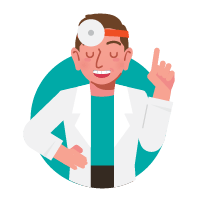The purpose of pediatric eye exams is to make sure that the child's eyes are developing properly and that their vision is healthy. It's also crucial to realize that a screening that a child may undergo at their pediatrician's office or school is not the same as a comprehensive eye exam done by a pediatric optometrist. Therefore, it's very important to have your child undergo a complete eye examination with their pediatric optometrist.
What to expect in a pediatric eye exam?
Ask if any changes to your child’s vision: During a pediatric eye exam, parents are asked what brought their child to the office and if they notice any changes in their child's vision or if they notice any problems at school.
Family history: Parents are asked about their family health and vision history before undergoing a full checkup.
Eye chart: Depending on the child's age, the appropriate eye chart is selected. The standard is a letter eye chart, but for children who may not be familiar with alphabets yet, a picture or different shapes may be used. In the case of a young child who is not yet verbal or a child with special needs, there are special charts that can be used to determine the child's vision without the need for verbal response.
Visual acuity for near and far: It is then determined whether the child can see clearly up close and from far away. A typical eye exam involves checking one eye at a time, then both together.
Eye Movements: During a pediatric eye exam the eye doctor will look at the child’s eye movements to make sure that both eyes are moving properly which is critical for reading. After that, the child's eye muscles are examined for deviations.
Developmental Visual Skills: One of the important things assessed during a pediatric eye exam is the full range of visual tools your child will need in the classroom and at play. Their eye teaming, binocularity, depth perception, color vision, and focusing skills are all part of an in depth pediatric eye exam.
Checking for astigmatism: Next, the child is examined for astigmatism. Their front part of the eye is also examined by placing them behind a microscope. Other methods may be used depending on their age. In the case of very young children, a transilluminator light or a magnifying glass may be used to examine the front part of the eye to ensure there are no infections or allergies.
Dilation of eyes: Their eyes are dilated to not only check out the back of the eye, but also to find out their real prescription since they usually have a strong focusing ability. While their prescription is measured before dilating their eyes, a special drop is used to relax their focusing abilities, because that will let the eye doctor know what their true prescription is, since after dilating their eyes and measuring their prescription again, they may be hiding a lot of plus power they were suppressing because they were over focusing. This provides a true indication of their prescription.
Power of lens for children: This is followed by prescribing the right power lens for the child.
Once all of the results are gathered, the eye doctor would discuss all of this information with the child and with the parent. Depending on the results, this may warrant further treatment.
Common eye problems found In children
Perceptual issues: If the child suffers from perceptual difficulties, neurological deficits, hand eye coordination problems, letter reversal issues, or poor eye tracking, further perceptual testing should be conducted. If the perceptual testing indicates an underlying visual problem the child will be recommended vision therapy to address those issues.
Myopia: Children with a minus prescription will be recommended to begin a program to slow down their progression. When a child is enrolled in a myopia management program, the aim is to slow down the progression of their minus prescription in order to prevent future vision problems that can arise from a high minus prescription. Learn more about myopia.
Amblyopia: If a child suffers from amblyopia, treatment is essential to try to strengthen that non-dominant eye. Learn more about amblyopia.
Early stages of testing
When a child is young, they have good plasticity, meaning they can adapt and change more rapidly. That's why it's so important to have a pediatric eye exam, so that if they have any of these issues, they are caught early on so that the condition does not progress and becomes more difficult to manage.
A pediatric optometrist prefers to see children between the ages of 6 and 12 months, then between the ages of 3 to 5 years just before entering school, and then before entering first grade between the ages of 6 and 7.
So be sure to visit your child's pediatric eye doctor to ensure your child's eyes are properly managed, diagnosed, and treated. They have extensive experience and training in working with children at all stages of their development.











